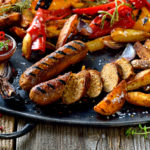Freedom with Food: Everything in Moderation?

Yes… but After You’ve Done the Work
You’ve heard it before: ‘Diets don’t work; the best bet is to have everything you want in moderation’.
Pardon?
If you’re like me at all, being on yet one more diet is not your first rodeo.
I began my own foray into the world of diets around age 15 when, after a knee injury I created by going just a tad too hard on the Jane Fonda VHS tapes I’d do in my living room led to a decrease in physical activity for a short period of time.
I was far from unconscious about what I was eating; mom was a hippy through and through so eating mindfully sourced and prepared, real food was the norm in our household.
However, that temptation that always called to me when I’d be at a friend’s house who had all the chips, all the ice cream, all the things, combined with not exercising as I had been, led to what was about a 10 pound weight gain.
I wasn’t having it.
I opted to go to the local weight watchers chapter which, back then, was still teaching what real portion sizes were and what food groups actually consisted of (far from the later points program that would evolve in which a person using all their points at McDonalds was technically still compliant).
In 1990, at age 15, the diet recommended to me was a whopping 900 calories per day.
I followed it, it worked, my knee healed and I was able to exercise again.
I lost weight and then some and I also began what would be decades of spending way too much time counting calories and going back and forth from labeling myself as good or bad based on how strictly I followed a ridiculously low daily caloric intake.
At the same time, my gut issues, which I’ve written about many a time, were getting worse and worse.
I couldn’t make heads or tails out of what to eat to leave me feeling lean and strong and energized and I couldn’t make heads or tails out of what to eat to not feel any of the plethora of gut disturbances I’d experience more and more often.
I tried the Blood Type Diet, The Zone, Atkins and hard core veganism (for 2 full years!).
In retrospect, all offered pearls of wisdom and learning but none of them shed even a glimmer of light on the importance of which foods might be causing inflammation, and none offered any leniency on how to eat in a sustainable manner in order to make the way I was feeling not feel like a diet.
It wasn’t until, in the early 2000s, I learned of Dr Loren Cordain’s work, and how an authentic Paleo Diet was truly the only way I’d found that in one fell swoop offered:
- A way to eat without feeling deprived
- A way to eat without weighing, measuring and counting calories
- A way to eat that allowed me to feel lean, energized, to compete at a higher and higher level in my sport
- A way to eat without feeling like I was limiting myself from anything I wanted
You may be reading this and think: “wait… Paleo IS a diet!” And “it IS restrictive!” And “won’t I need a cheat day?”
Which may lead you back to another common piece of advice given: isn’t better to eat everything in moderation?
To which I would reply, to all of the above, no.
No, that is, unless you’ve already done the work.
What work?
The work of first learning what foods actually make you feel anything less than optimally.
I did this work; it took me a long time, much longer than it takes my clients to do now, because I was figuring out what the heck I was doing as I was going, rather than being guided by anyone who was able to help me.
And the biggest thing I learned, the largest takeaway of all, is that once a person realizes which single foods make them feel awful, and which foods make them feel incredible, something tips, something resonates so deeply that a fundamental connection is made and the food can suddenly seem completely uninteresting.
When I realized that for me, soy and gluten were, by far, the two most deplorable things I could put into my body (followed by all other grains as well as beans, and of course, man made sugars or fats), they, and all foods containing them, became about as attractive to eat as a container they may have been sold in.
I like to call it the cardboard effect; my suspicion was that I’d likely be able to digest a cardboard box and suffer less consequence than the soy or gluten-rich item itself.
And now, nearly 20 years later, I can honestly say that I do eat everything I want, but that’s because everything I want are foods that make me feel nourished, healthy, energized, clear, focused.
I would not ever now proactively choose to eat something that I knew would make me feel anything less than, any sooner than I’d go back and eat more of a dish from a restaurant that I knew gave me food poisoning.
It truly is that simple… but there’s a but.
Each person has to be ready to do this work, both practically in terms of feeling prepared to tune in to their body and listen to what it has to say, as well as behaviorally in order to figure out what the hurdles are that each of us place in our own way.
Over the years, I’ve had the honor to work with some incredible people that have done such work; and there’ve also been clients who begin the process and realize it’s not the right time in their lives amongst all the other things going on.
So when I hear someone suggest eating everything in moderation, or that they’ve come to terms with their bodies being far heavier than they wanted or they’re settling.
Settling for feeling tired all the time.
Settling for having GI issues day in and day out, or, you name it, I can’t help but wonder whether they’ve truly given themselves a fair shot at finding out their own true best path to eating in a manner which really does lead them to the same place many would like to be in, after perhaps years of being in what is effectively a food fight with one’s self: being in a place of food freedom.
And thriving!





